Secrets of successfully growing the Black Moor tomato
Black tomatoes attract attention with their unusual coloring. But few people know that dark fruits, due to the presence of anthocyanin pigments in them, have an antioxidant effect on the body, increase immunity and even stimulate male potency.
Dark-fruited varieties include, among others, the Black Moor tomato. Further in the article we will look at its features and secrets of successful cultivation.
Characteristics and description of the variety
The main properties of Black Moor tomatoes include:
- Mid-ripening. From germination to fruit ripening, 105-115 days pass.
- High yield. From one bush, if agricultural techniques are followed, you can get 4-6 kg of harvest.
- Semi-determinacy. Plant growth stops after the formation of 10-12 clusters.
- Average height. The height of the plant reaches 140-180 cm.
- Unpretentiousness. Suitable for growing both in greenhouses and in open ground.
Tomatoes of this variety have a plum-shaped shape and a sweet taste.. They grow small, weighing 40-50 g. 10-15 fruits are formed on one brush. In the photo you can see what they look like:
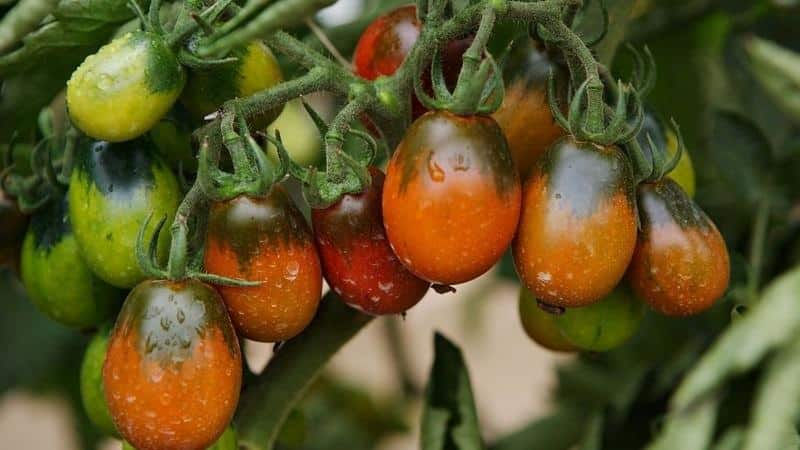
Until fully ripe, the fruits have a green spot near the stalk. The color of tomatoes ranges from red-brown to close to black. This is affected by the acidity of the soil in which the tomato bush grows. If the soil is acidic, the tomatoes will grow red-brown. If the soil pH is neutral, the color will be close to black.
Attention! Experienced gardeners have found a way to obtain tomatoes of this variety with the most black color possible.They reduce the acidity of the soil with the help of ash: they add it at the rate of 1 kg per 1 sq. m. m.
Advantages and disadvantages
The Black Moor variety has several advantages:
- plants tolerate temperature changes well and, in warm weather, bear fruit until mid-autumn;
- unusual coloring of fruits;
- sweet taste of tomatoes;
- high productivity;
- can be grown outside.
Among the disadvantages, tomato growers highlight the following:
- you need to pluck, tie up and shape the bush;
- the fruits have thin skin and juicy pulp, which is why they do not tolerate transportation well;
- whole fruits are not suitable for canning;
- tomatoes are heavily eaten by pests;
- plants are susceptible to diseases.
Features of care and cultivation techniques
The process of growing dark-fruited tomatoes is similar to the care procedure for regular red tomatoes.
Read about other tomato varieties:
Tomato "Samara" and its advantages over other types of tomatoes
Seed preparation
Before planting, seeds are checked for germination. They are placed in a glass and filled with water at room temperature. Those seeds that have sunk to the bottom are suitable for planting.
To increase germination, seeds are soaked in a growth stimulant solution: for example, “Epin” or “Zircon” (the solution is prepared according to the instructions of the drug manufacturer).
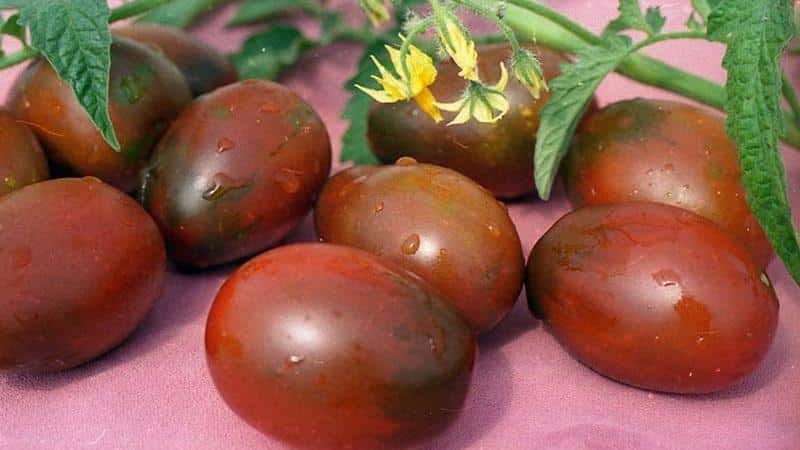
Sowing seeds for seedlings
It is better to plant seeds for seedlings in March.
Attention! If you are unsatisfied with the germination of the seeds, you will have plenty of time to plant additional plants.
It is better to buy ready-made soil in the store. — preparing the land from your site will take a lot of time.
The seeds are planted 1-1.5 cm deep into the soil and sprinkled with a layer of soil.. The container with soil is wrapped in plastic film, creating a microclimate favorable for seed germination. Before emergence, the container is placed in a dark place. When the shoots appear, they are brought out into the light (the film is removed). When the soil dries out, carefully water the sprouts with settled water.
Picking seedlings
When several true (not cotyledon) leaves appear, tomato seedlings dive - plant each plant in separate containers. In them, tomatoes will grow and develop before being planted in their main growing location.
Planting seedlings in a permanent place
Plants are transplanted to a permanent growing location in mid-May (in a greenhouse) and during the first week of June, when the threat of morning frost has passed (in open ground).
Planting scheme: 40-45 cm between plants in a row and 60 cm between rows.
Before planting, each hole is spilled with water and complex fertilizers are added.containing nitrogen, phosphorus and potassium (dosage - according to the manufacturer's instructions).
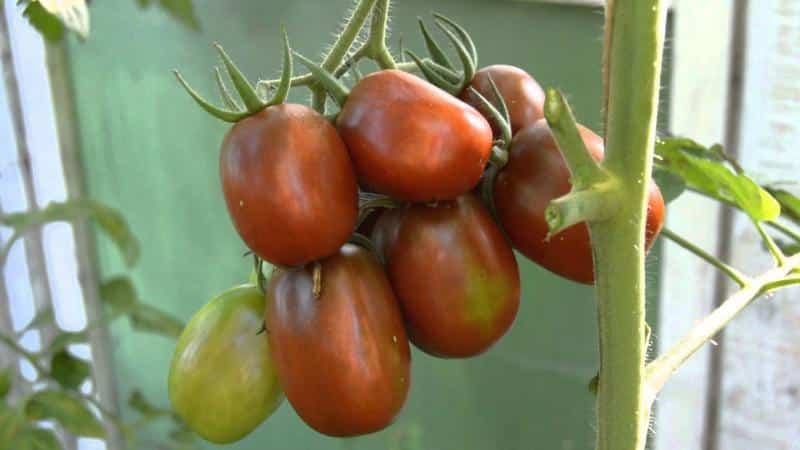
Plant care and feeding
Experienced gardeners before tomato flowering (in the budding phase) spray the aboveground part of the plants with a solution of boric acid. It is prepared from 1 teaspoon of boric acid crystals and 1 glass of hot water. After dissolution, the mixture is poured into 10 liters of water at room temperature. To obtain a good harvest, the resulting solution is generously sprayed from a spray bottle onto the leaves, stems and buds.
Important! It is advisable to carry out this feeding in cloudy weather or after sunset. This is necessary so that wet leaves do not get sunburn.
Tomato bushes grow tall and therefore need to be tied to supports.
Plants are taking stepson: remove young shoots that form in the axils of the leaves. Stepping is done 1-2 times a week, in the morning or evening. Columns from removed shoots are left 1.5-2 cm high.
Black Moor bushes form 1-2 stems.
Attention! In greenhouses in warm sunny weather, plant flowers are pollinated by slightly shaking the flower brushes. This way it is possible to achieve more ovaries.
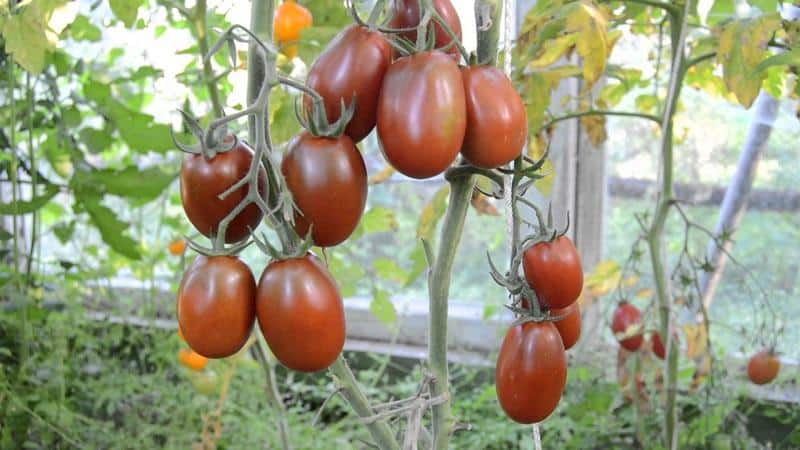
Watering and loosening
Before flowering, plants are watered every 4-6 days. at the rate of 4-5 liters per 1 sq. m. During flowering and fruiting, watering is increased to 8-10 liters.
After watering, the soil around the bushes is loosened and sprinkled with dry soil.. We weed the rows 1-2 times a week. A few weeks after planting, the plants are earthed up: the base of the stem is sprinkled with 2-5 cm of soil. Additional roots will then develop in the sprinkled part, which improve the nutrition of the bush.
Harvesting
July and August are the time for ripening and harvesting. Regular harvesting of tomatoes will contribute to the smooth ripening of the remaining fruits. You can collect unripe tomatoes, put them in boxes and leave them to ripen in a dark place.
Attention! Red-fruited brothers can be added to unripe dark-fruited tomatoes. This will speed up the ripening process.
Diseases and pests
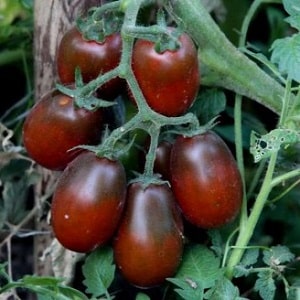 One of the disadvantages of the Black Moor is susceptibility to disease. As a preventative measure, it is recommended to spill the soil (even purchased) with a solution of copper sulfate at the rate of 1 tbsp. spoon per 1 liter of water.
One of the disadvantages of the Black Moor is susceptibility to disease. As a preventative measure, it is recommended to spill the soil (even purchased) with a solution of copper sulfate at the rate of 1 tbsp. spoon per 1 liter of water.
To prevent blossom end rot (it indicates a lack of calcium and appears as spots on the top of the fruit) you can make root dressings from ash. The solution is prepared by diluting 0.5 liters of ash in 4-5 liters of water. 0.5 liters of fertilizer are used per bush.
The main pests of tomatoes are whiteflies and aphids.. If they appear, the plant can be treated with Imidor (1.5 ml per 10 liters of water). Tomato growers also use spraying the bushes with garlic tincture as an effective method of pest control. It is prepared by infusing 200 g of garlic cloves in 5 liters of water for 5-6 hours. The resulting tincture is generously irrigated on both sides of the stems and leaves of tomatoes.
More about tomato varieties:
Tomato “Chocolate Miracle”: reviews and photos of the harvest
Reviews from tomato growers
On Internet forums There are different reviews about the Black Moor variety, mostly positive..
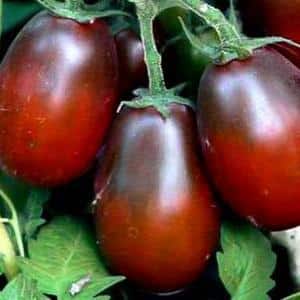 Elena, Moscow region: “We grow black tomatoes every season. We alternate varieties. Last year we tried Black Moor. They taste very sweet and look beautiful on the bush: on the brush they are almost all the same size. I read that if you regularly consume these fresh tomatoes, your immunity increases, your skin condition improves and metabolic processes accelerate.”.
Elena, Moscow region: “We grow black tomatoes every season. We alternate varieties. Last year we tried Black Moor. They taste very sweet and look beautiful on the bush: on the brush they are almost all the same size. I read that if you regularly consume these fresh tomatoes, your immunity increases, your skin condition improves and metabolic processes accelerate.”.
Oksana, Kirov: “We didn’t get big yields from this variety. Perhaps they should have fertilized better. But the bushes bore fruit until autumn. The whole family noted that dark tomatoes look very appetizing in fresh summer salads.”.
Anatoly, Krasnodar: “I grew this variety in open ground in the summer. The fruits are not large, but there are many of them. You definitely need to tie them up: the brushes are large and can break off the bush.”.
Let's sum it up
Tomatoes of the Black Moor variety contain anthocyanins, which have an antioxidant effect and inhibit oxidative processes. These tomatoes are healthy for the body and very beautiful to look at: the fruits grow even and calibrated.
Caring for the variety is standard: gartering, pinching, watering, weeding and fertilizing.But the Black Moor is susceptible to diseases, so increased protective measures will be required. If you follow all the recommendations, the variety will certainly delight you with a stable harvest!